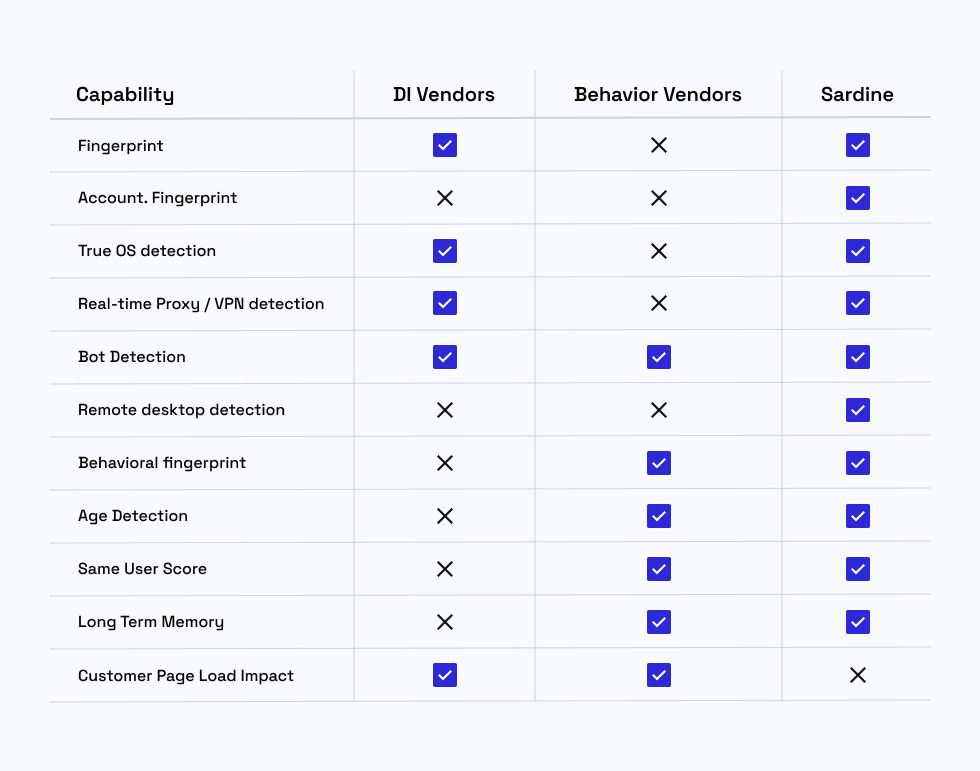Device Intelligence and Behavior Biometrics work better together
For nearly two decades, companies have fought fraud and anti-money laundering by looking for signals coming from digital devices and how users behave on those devices. Today, however, fraudsters have outpaced these techniques. Device intelligence is table stakes, but often behavior biometrics is considered a luxury or add-on.
Rarely are these two capabilities deeply integrated
What is Device Intelligence?
Device intelligence is a field that involves the gathering and analysis of data related to a specific device's characteristics and behavior. It started taking shape with the rise of smartphones and smart devices in the mid to late 2000s, but its origins can be traced back to early computer systems.
In the early stages, device intelligence focused on identifying characteristics such as device type, operating system, IP address, and other static parameters. As the technology evolved, more sophisticated measures like device fingerprinting emerged, combining multiple parameters to identify a device uniquely
What is Behavior Biometrics?
Behavior biometrics refers to technology that measures and analyzes human behavior patterns, particularly those related to the interaction with digital devices. While traditional biometrics, like fingerprints and facial recognition, are focused on physical characteristics, behavior biometrics emphasizes the user's unique way of interacting with devices.
The concept of behavior biometrics can be traced back to the 19th century when telegraph operators could identify each other based on their unique "fist," or style of telegraphy. However, it wasn't until the digital age that behavior biometrics started to take shape as a field of study.
In the early stages, behavior biometrics included basic measures like keystroke dynamics. As technology evolved, the field expanded to include more complex behaviors, such as mouse movement patterns, touchscreen interactions, and even patterns in device usage.
Challenges facing these techniques
Device Intelligence:
- Limited Accuracy: Device intelligence primarily depends on the data it collects, but some parameters can be misleading. For instance, IP addresses can be masked, location data can be spoofed, and device fingerprints can be altered.
- No emulator or RDP detection: Fraudsters have started to use tools and techniques that can mask or change device characteristics, making them appear as new or different devices. Techniques like "device spoofing", using botnets or remote screen-sharing applications.
Behavior Biometrics:
- False Positives: Behavioral biometrics can sometimes mistake legitimate users for fraudsters if their behavior changes significantly—for instance, if they're using a new device or are in a different environment. This can lead to unnecessary user friction.
- Luxury item: Device intelligence has become table stakes, but often behavior biometrics is an add on, and may not be available in cost-constrained environments despite its significant improvement
The integration problem
Perhaps the biggest challenge facing fraud and compliance departments is combining multiple vendors with their internal systems to bring the best level of protection. Many tools simply return scores. They were also never designed to work together.
The incumbent solutions create a patchwork that creates gaps exploited by the criminals.
The Sardine solution
Sardine is the only Device and Behavior driven fraud & compliance platform designed to work together. Sardine is not a black box and makes all of its signals available to customers. Sardine’s rules engine can combine multiple data-sources and become the operating system for fraud and risk teams.
Sardine is also the only device and behavior platform that can detect bots and emulators and all remote screen-sharing applications (RDP).

